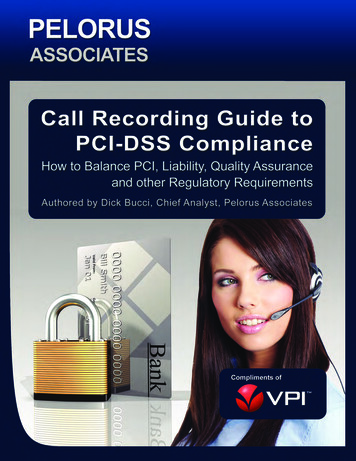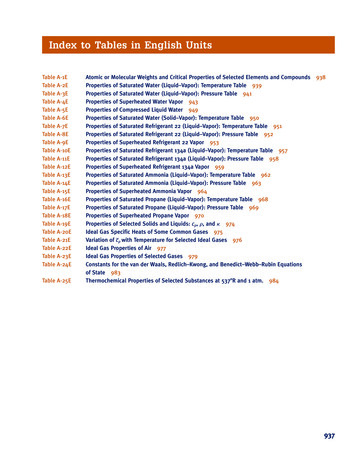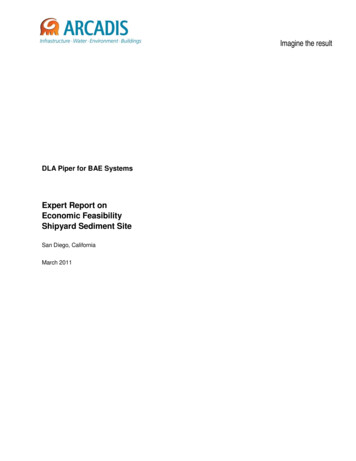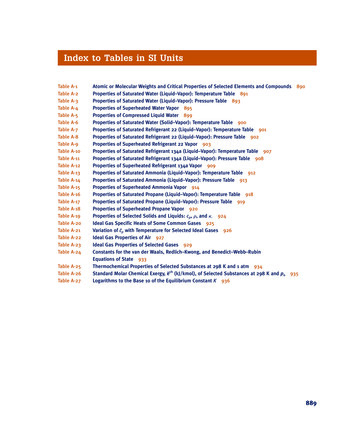
Transcription
TABLE OFCONTENTSTable of ContentsIntroductionPage 3Cyber CrimePage 3Contact Centers and Identity TheftPage 3Payment Card Industry ResponsePage 4PCI-DSS Requirements Impacting Call RecordingPage 5Other PCI-DSS Requirements that Impact Call RecordingPage 6Alternative 1 - Cease RecordingPage 7Alternatives 2 and 3 - Agent-driven CompliancePage 7Alternative 4 - Transfers to Third Party DevicesPage 8Alternative 5 - Do NothingPage 8Alternative 6 - Invest in Intelligent Call Recording SystemsPage 8VPI SolutionPage 8Consequences of Non CompliancePage 10Advisable Best PracticesPage 11Advisable Best Practices for Securing At-Home AgentsPage 12Dilemma for Contact CentersPage 12Telemarketing Sales RulePage 13FSA RulesPage 13BASEL IIPage 13Sarbanes-Oxley ActPage 13Gramm Leach Bliley Finacial Services Modernization ActPage 13TILA and FDCPA ActsPage 13Barclaycard GuidancePage 14Executive SummaryAbout the AuthorAbout VPIPage 14Page 15Page 15
IntroductionIdentity theft was the number one source of consumer complaints to the Federal TradeCommission (FTC) in 2007. Estimates by private market research firms peg the incidenceof identity theft as high as 15 million consumers. The most common form of identity theft,according to the FTC, is the misuse of credit and debit card accounts. Approximately 3.4million adults can expect to have their payment card data compromised every year. Whencredit card identities are stolen, it’s not just the credit card companies that are left holdingApproximately 3.4 millionthe bag – cardholders often face economic losses, lengthy legal battles and struggles to re-adults can expect to haveestablish clean credit records. While for most consumers the impact is modest, according totheir payment card datathe FTC one out of twenty victims suffer median out of pocket loses of 400 and spend 60compromised every year.hours trying to clean up the mess that resulted.One out of twenty victimsCyber Crimesuffer median out of pocketloses of 400 and spendFor today ’s high-tech thieves, software is a much more productive and arguably less60 hours trying to clean uprisky way to take other people’s money than dumpster-diving for card receipts or pickingthe mess that resulted.pockets. A class of software known generally as malware can unsuspectingly creep into- FTCdata bases and extract hundreds of thousands of account identifiers. Malware is alsospread by propagating a worm or virus or by making the malware available on a website that exploits a security vulnerability. Common techniques include phishing, key andscreen loggers, and SQL injection attacks. According to The Crimeware Landscape:Malware, Phishing, Identity Theft and Beyond, a report published by the U.S. Departmentof Homeland Security in 2006, “Credible estimates of the direct financial losses due to“phishing” alone exceed a billion dollars per year.”The largest security breach to date was disclosed in January 2009. The case involvedHeartland Payment Systems Inc. Heartland processes more than 100 million cardtransactions per month for 250,000 clients. On August 17, 2009 Albert Gonzalez, 28, ofCredible estimates of theMiami Florida was charged by the Department of Justice with stealing data from 130 milliondirect financial losses duedebit and credit card holders. According to the indictment, Gonzales and international co-to “phishing” alone exceedconspirators used an intricate hacking technique called an “SQL injection attack,” whicha billion dollars per year.”seeks to exploit a computer network by finding a way around firewalls to steal credit anddebit card information. It turns out that Gonzales and his thugs were also responsible- U.S. Department of HomelandSecurityfor the highly publicized intrusion of TJ Maxx card holders. Heartland expensed 144.2million to consummate the settlement of claims.Contact Centers and Identity TheftContact centers can become unsuspecting targets of cyber criminals. Outbound telemarketingcenters, inbound centers that engage in up-selling and/or cross -selling, service providers,and collection companies always take payment in the form of credit or debit cards. The cardinformation is entered into a CRM or other sales automation software and recorded by voiceand screen recorders. And there it resides - thousands and even millions of card recordsinviting remote criminals or even greedy employees to extract for personal gain or sell intoa sophisticated secondary market.3
Think it can’t happen?An investigative reporter from the BBC (British Broadcasting Company) posed as a fraudster seekingto buy credit card records from a fence in Delhi. The Indian conspirator offered to sell details onhundreds of plastic cards for 10 each. The video shows a buy being made and money changinghands. The reporters bought 50 cards as a “sample” with the hint that a larger buy would followif the cards checked out. The names were later traced to a call center taking service calls for U.S.based Symantec Corporation.In 2006, an employee atthe HSBC Data ProcessingAlso in India, local police in the city of Pune arrested 12 persons associated with a call centerCenter in Bangalore,operated by outsourcer MphasiS for allegedly siphoning off 350,000 from the Citibank accountsIndia was arrested forof four US citizens. Some employees gained the confidence of customers and obtained their PINallegedly passing personalnumbers to commit fraud. They did this under the guise of helping the customers out of difficultcustomer information. As asituations.In 2006, an employee at the HSBC Data Processing Center in Bangalore, India was arrested forallegedly passing personal customer information. As a result UK bank customers lost approximatelyresult UK bank customerslost approximatelyUSD 425,000.USD 425,000. The incident cast a black eye on outsourcing work to India and may affect futureprojects being considered to India and other parts of Asia.According to IT Business News, the HSBC incident was brought to notice by some of its customers inEngland who complained that money was transferred out of their accounts without their knowledge.The lessons from these incidents at HSBC have prompted several security and quality assurancepolicies aimed to protect customers’ sensitive personal information. A dedicated team of complianceofficers have been specially trained and deployed to ensure that breaches in security and access ofcustomer information will be minimized.According to press reports, Alaska Airlines and Horizon Air had to notify 1,500 of their customers thattheir credit cards may have been misused by a former call center employee. The former employeeIn order to reduce fraud, theis alleged to have taken the card information provided from some of the airlines’ customers to payPayment Card Industry (PCI),for reservation changes. Rather than process the payment on behalf of the airlines, the individual iswhich consists of Americanalleged to have diverted the funds to a personal account.Express, Discover FinancialServices, JCB International,In the first example, Symantec followed up with a thorough investigation of the underground economy.Among the findings from their 68-page report was that the BBC reporters grossly overpaid for customercard data. Quoting from the report, “Credit cards are also typically sold in bulk, with lot sizes from asfew as 50 credit cards to as many as 2,000. Common bulk amounts and rates observed by SymantecMasterCard Worldwide, andVisa Inc. established the PCISecurity Standards Councilin September 2006.during this reporting period were 50 credit cards for 40 ( 0.80 each), 200 credit cards for 150( 0.75 each), and 2,000 credit cards for 200 ( 0.10 each).”Payment Card Industry ResponseIn order to reduce fraud, the Payment Card Industry (PCI), which consists of AmericanExpress, Discover Financial Services, JCB International, MasterCard Worldwide, and Visa Inc.established the PCI Security Standards Council in September 2006. The aim of the councilwas to establish a set of rules that merchants and service providers must comply with in orderto accept payments through the credit and debit card apparatus set up by the card vendors.While the Council is managed by the card industry, membership is open to any organizationthat participates in the payment processing system, including merchants, processors, POSvendors, and financial institutions.4
The Council subsequently issued a Data Security Standard (PCI-DSS) which details securityrequirements for members, merchants and service providers that store, process or transmitcardholder data. The original PCI regulations specifically forbade storing primary accountnumbers (PAN), PIN numbers, service codes, expiration dates, and other specified identifiersunless they met PCI-DSS encryption standards. Payment processors, service providers andmerchants that process more than 20,000 e-commerce transactions and over one millionPayment processors, serviceregular transactions are required to engage a PCI-approved Qualified Security Assessor (QSA)providers and merchantsto conduct a review of their information security procedures and scan their Internet pointsthat process more thanof presence on a regular basis. However, no organization that accepts cards issued by the20,000 e-commercefounding members of the council is exempt from compliance.While the standard is primarily aimed at cardholder information in data bases, contact centerscan easily become unsuspecting violators. This is because of the practice of collecting andentering card data into order entry systems and archiving private customer information incall and data recording systems. Initially, the PCI-DSS allowed the voice and data recordingand storage of sensitive card information provided that certain safeguards were in place, suchas encryption, firewalls, and need to-know authorizations. The precise levels of encryption arespelled out in the standard as are data categories that may be stored when properly encrypted.transactions and over onemillion regular transactionsare required to engage aPCI-approved QualifiedSecurity Assessor (QSA)to conduct a review oftheir information securityprocedures and scan theirInternet points of presencePCI-DSS Requirements Impacting Call Recording Do Not Record Validation CodesOn October 28, 2010 the Standards Security Council issued a clarification that states that it is aviolation of the PCI-DSS to store card validation codes and the full contents of and track from themagnetic stripe located on the back of the card. This includes the cardholders name, the primaryaccount number (PAN), and expiration date, and personal identification number (PIN) after authorizationeven if encrypted. Note: it is permissible for issuers and companies that support issuing services to storesensitive authentication data if there is a business justification and the data is stored securely.On October 28, 2010 theStandards Security Councilissued a clarification thatstates that it is a violation ofthe PCI-DSS to store cardvalidation codes and the fullcontents of and track fromthe magnetic stripe locatedon the back of the card.The card validation value code is the three or four digit number that is usually imprinted nextto the signature line on the back of the payment card. On American Express cards, the securitycode is on the face of the card.The Card Verification Code (referred to as CAV2, CVC2, CVV2, or CID) must not be retained postauthorization, cannot be stored in a standard digital audio or video format (e.g. wav, mp3, mpg, etc.),and a proper disposal procedure must be in place. If the recording solution cannot block the audio orvideo from being stored, the code must be deleted from the recording if it is initially recorded.5
When it is absolutely necessary that your organization retain card verification codes, you will need todemonstrate to your QSA (Qualified Security Assessor) and your acquiring bank that:You perform, facilitate or support issuing services - it is allowable for these types of organizationsto store sensitive authentication data only if they have a legitimate business need to store suchdata. It should be noted that all PCI-DSS requirements apply to issuers, and the only exceptionfor issuers and issuer processors is that sensitive authentication data may be retained if there is alegitimate reason to do so. A legitimate reason is one that is necessary for the performance of thefunction being provided for the issuer and not one of convenience. Any such data must be storedsecurely and in accordance with PCI-DSS and specific payment brand requirements.Telephone order takers require the validation code as well as the PAN (Primary Account Number) and expirationdate in order to secure authorization from the card issuer. Without that number, cyber thieves cannot makeTelephone order takerseCommerce purchases or illegally transfer funds out of the cardholders’ accounts. The standards committee maderequire the validation codethe change because of the availability of sophisticated malware that could penetrate encryption algorithms.as well as the PAN (PrimaryThe latest PCI-DSS standards require that PAN must be rendered unreadable anywhere it is stored (includingon portable digital media, backup media, and in logs) by using any of the following approaches:One-way hashes based on strong cryptography (hash must be of the entire PAN)Truncation (hashing cannot be used to replace the truncated segment of PANIndex tokens and pads (pads must be securely stored)Strong cryptography with associated key-management processes and proceduresNote: It is a relatively trivial effort for a malicious individual to reconstruct original PAN data if they haveaccess to both the truncated and hashed version of a PAN. Where hashed and truncated versions of thesame PAN are present in an entity’s environment, additional controls should be in place to ensure that theAccount Number) andexpiration date in order tosecure authorization fromthe card issuer. Withoutthat number, cyber thievescannot make eCommercepurchases or illegallytransfer funds out of thecardholders’ accounts.hashed and truncated versions cannot be correlated to reconstruct the original PAN.Other Important PCI-DSS Requirements that Impact Call RecordingRequirement 4 and Subsection 4.1 require that strong cryptography and security protocols suchas secure sockets layer (SSL)/transport layer security (TLS) and Internet protocol security (PISEC).Requirement 7 and Subsection 7.1 require that access to computing resources and cardholder informationonly to those individuals whose job requires such access, e.g. for strong business reasons. Organizationsshould create a clear policy for data access control to define how, and to whom, access is granted.Requirement 7 and Subsection 7.2 require organizations that accept payment cards to establish amechanism for systems with multiple users that restricts access based on a user’s need-to-know and is setto “deny all” unless specifically allowed.Requirements 8 and Subsection 8.1 require organizations that accept payment cards to Assign a uniqueID to each person with computer access before allowing them to access system components or cardholder data.Subsection 8.3 requires a two-factor authentication for remote access to the network by employees,administrators and third parties.Subsection 8.5 requires proper user authentication and password management for users andadministrators on all system components.Subsection 8.5.16 requires organizations that accept payment cards to authenticate all access to any databasecontaining cardholder data. This includes access by applications, administrators, and all other users.6
Requirements 10 and Subsection 10.1 require card acceptors to track and monitor all accessto network resources and card holder data and establish a process for linking all access to systemcomponents to each individual user.Requirement 10 and Subsection 10.2 require card acceptors to implement automated audittrails for all system components to reconstruct events such as user access to cardholder data, access toYou must be able to man-audit trails, use of authentication mechanisms, and the like.age call quality and thereIf an important part of the agent’s job is to accept and/or solicit sales, then the question becomes:how do we prevent recording and storing of sensitive authentication data and the full contents of anymagnetic stripe track?Available AlternativesAlternative 1: Cease recording all sales and transaction calls.are laws and regulationsthat many centers, particularly outbound, needto comply with. Full-timerecording is the only way tomeasure compliance.Alternative 2: Train agents to disable the recording function when card data is required thenrestart after the transaction is completed.Alternative 3: Require agents to delete the section of the recording that includes the authorization code.Alternative 4: Third-party devices that require the caller to enter card details via their touchtone pad.Alternative 5: Do nothing.Alternative 6: Invest in call recording systems that automatically mask and mute sensitive card details.Alternative 1 - Cease RecordingThe notion of simply halting the practice of recording all calls and related data that may involve thecapture of interactions containing sensitive information is certainly an approach that will be compliant.Thieves cannot steal information that was never stored. However, the trade-off is too severe. You mustbe able to manage call quality and there are laws and regulations that many centers, particularlyoutbound, need to comply with. Full-time recording is the only way to measure compliance.Alternatives 2 and 3 - Agent-driven ComplianceAt the final stage of taking credit card data, recorded agent could transfer the call to an unrecordedextension where a second agent takes aspects of the customer credit card data such as the CVV number for bank verification. Some recording systems allow the agent to manually pause and resume therecording via buttons on their screen or handset.At the final stage of takingcredit card data, recordedagent could transfer the callto an unrecorded extensionThese approaches may work but it adds a burden to agents and is obviously error-prone. Therewhere a second agent takesmay also be a question of whether relying on employee actions would pass muster with the paymentaspects of the customercard council which prefers solid, technology-based solutions.credit card data such asAlternative 4 - Transfers to Third Party DevicesThere are third party devices that can be bolted onto an existing recorder. This method works by re-the CVV number for bankverification.quiring the caller to enter card details manually via the touchtone pad. The idea has merit, since littleagent intervention is required and the system automatically masks card entries on the agent screenand blocks the DTMF tones from being recorded. Agents could also transfer calls to an IVR platformfor taking such details as CVV for bank verification. The downsides are the paucity of choices, risk ofuser error, the unnatural interruption of call flow, the need to manage an adjunct device that’s notpart of an integrated solution, and an added cost per transaction.7
Alternative 5 - Do NothingThe ‘do nothing” option appears to be the favored choice at this point. In the 2009 Data BreachInvestigations Report conducted by the Verizon Business RISK Team researchers uncovered 90 confirmedbreaches within their 2008 caseload encompassing an astounding 285 million compromised recordsand 81% of businesses were not Payment Card Industry (PCI) compliant. The most common form ofA 2009 poll of Uniteddata breach was compromised payment cards, with retail and financial services accounting for six outKingdom call centerof ten of the security breaches.managers found that moreA 2009 poll of United Kingdom call center managers found that more than 19 in 20 call centers dothan 19 in 20 call centersnot delete or mask credit
Alternative 6 - Invest in Intelligent Call Recording Systems Page 8. VPI Solution. Page 8. Consequences of Non Compliance. Page 10. Advisable Best Practices. Page 11. Advisable Best Practices for Securing At-Home Agents. Page 12. Dilemma for










